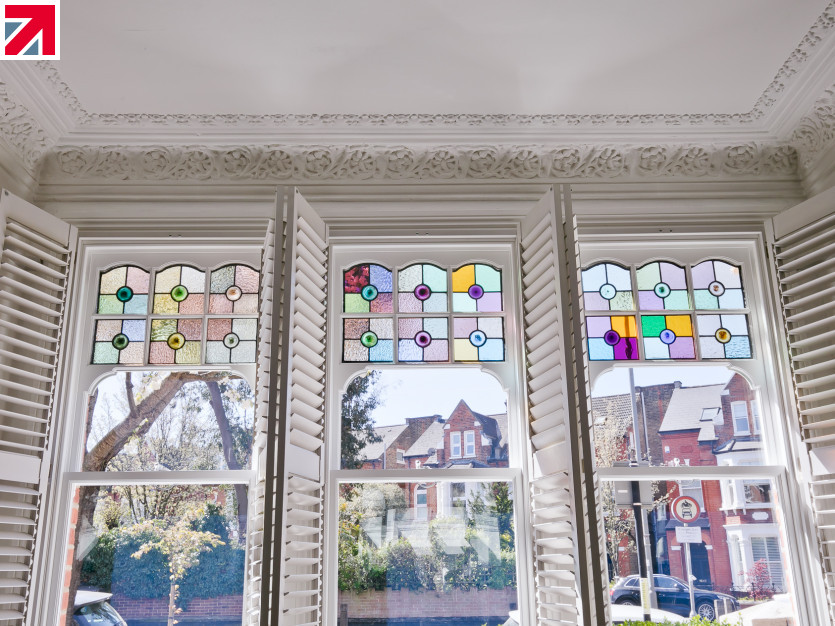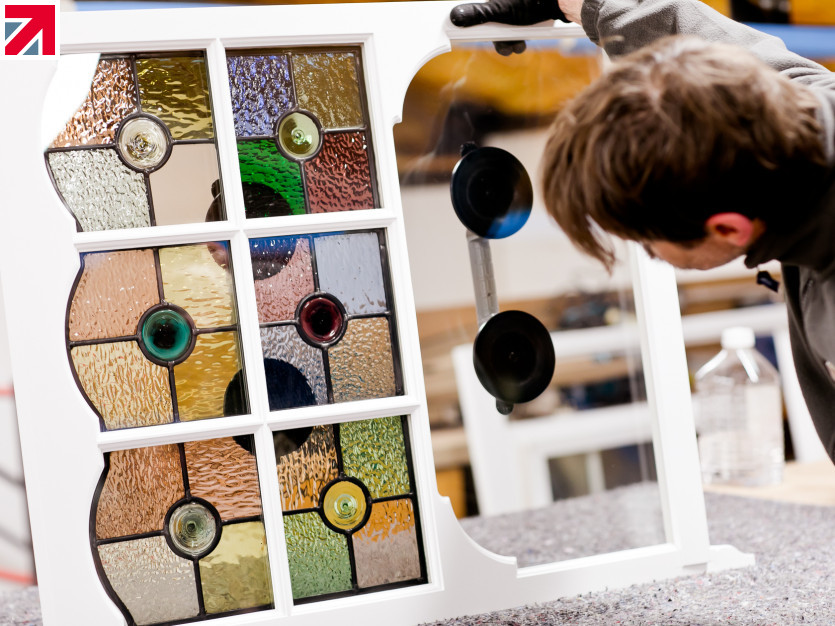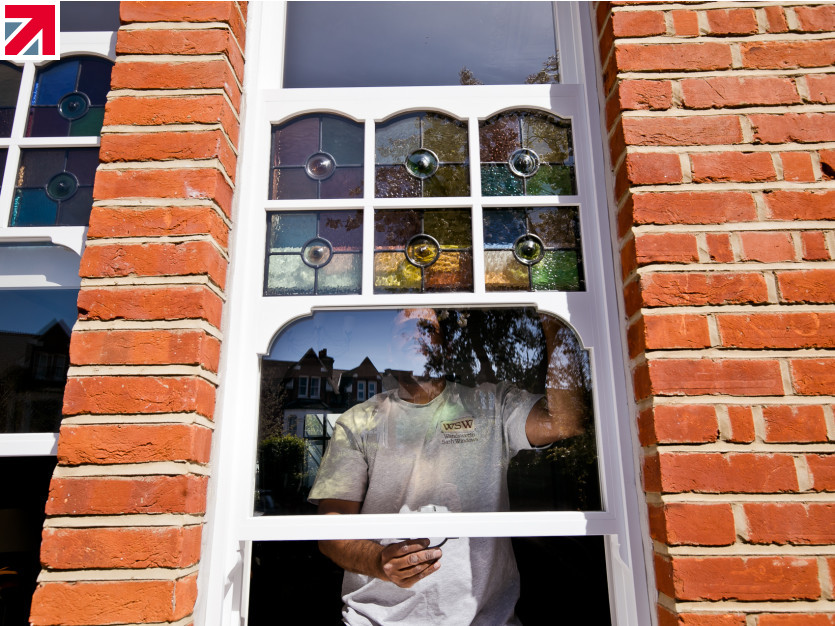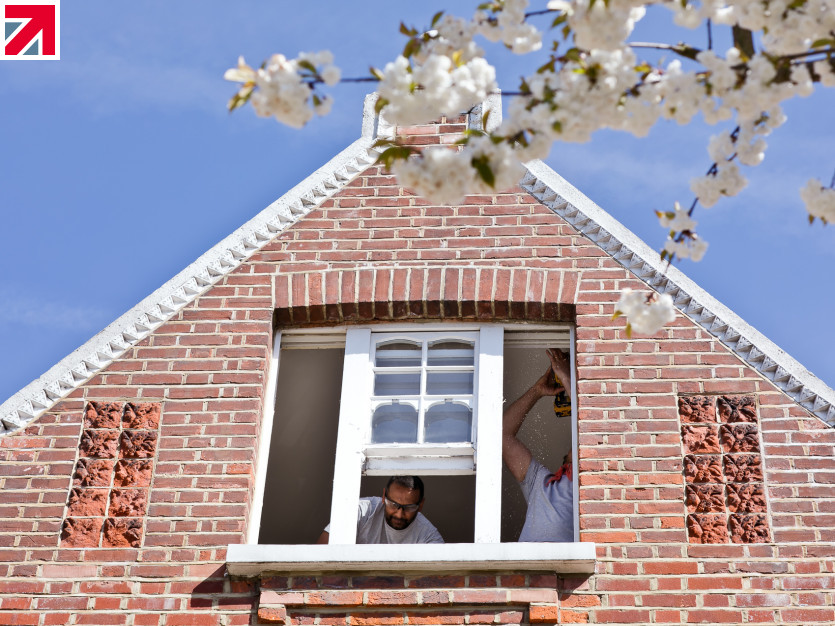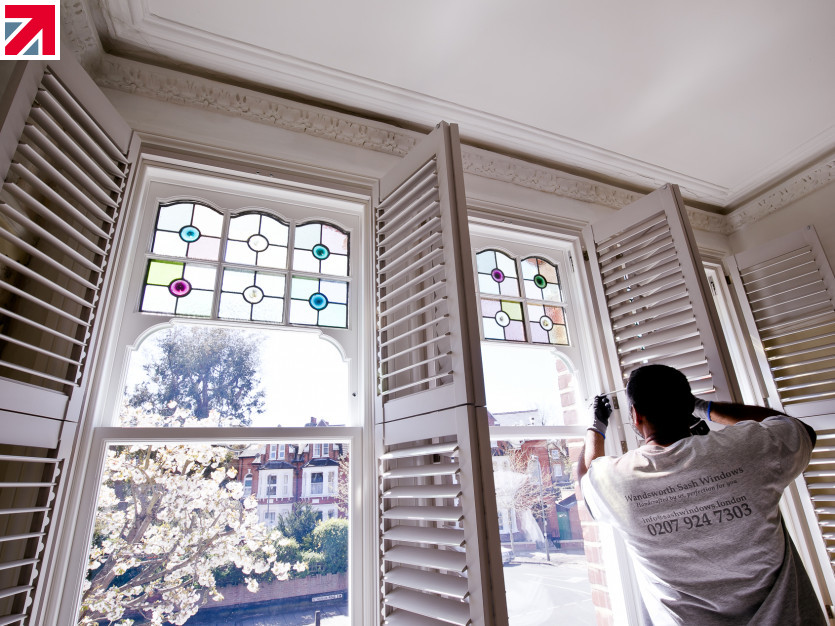An incredible 1000+ man hours split amongst 14 people involved throughout the process - 10 times the number of man hours consumed compared to a typical simple window replacement.
Unbelievably, during the 2020/2021 lockdowns, we took on our biggest stained-glass project yet. The owner of a beautiful property based in Balham wanted:
- 9 sash windows on the first two floors of the property (plus a large triple window on the top floor) to be completely replaced (including the frames) with new traditional timber double glazed sashes.
- To restore and retain the original stained glass that features in the upper section of each window and insert new stained glass into the window on the top floor of the property to perfectly replicate the originate pattern used within the lower levels.
The whole team were excited to take on such a challenging, technical project.
Why was this project so involved?
A regular double glazed sash window unit is made up of two sheets of glass with a 16mm gap between the two. The gap is filled with inert gas to provide the associated insulation properties achieved by double glazed glass. Once made, we would normally measure for the glass, then remove the old and install the new all in one go. However, this project required us to restore the existing stained-glass panes prior to making the new double-glazed glass which would eventually house the restored stained-glass panes within them.
To do this, it meant taking out the original stained-glass windows and temporarily fitting some clear glass into the old window frames. This enabled us to take the original stained glass back to our workshop and work on restoring the glass before manufacturing the new double glazed glass windows around them.
In the workshop:
Once all the original stained glass was brought back to our workshop, it was meticulously compared.
Restorative works included:
Replaced the perimeter lead with that of the original type – whilst in its frame, stained glass can look like it is in relatively good condition due the lead around the edge of the pane holding it in place. Once the glass is removed however, it isn’t uncommon for it to start disintegrating, as was the case at this particular property. When working with original stained glass such as this, installed more than 100 years ago, the lead that holds it in place has been painted over many times, it has had putty on it, and has generally battled the elements for a long time. We replaced the lead with the original type so that over time it will tarnish slightly and darken in colour.
Replaced cracked and damaged coloured panes with colour matched glass – the disintegration of the perimeter lead resulted in the corner pieces of coloured glass starting to fall out and crack so some of the pieces needed to be replaced. The difficulty was finding a precise colour match to replace it with. Normally, if we need to replace a section of glass in a stained-glass piece, we would search at reclamation yards, antique glass specialist shops or the like. Being so old and unique, it wouldn’t be something that we could buy off the shelf. However, this project took place during the peak of the Coronavirus pandemic when our usual outlets were closed. This made it very difficult to source.
Created uniform leadwork – there is a 3mm lead border around each coloured pane which required us to make the windows, so the timber showed exactly the same amount of lead all the way around. It sounds easy, doesn’t it? However, being originally manufactured in the Victorian era, each pane was actually a slightly different size. One was 10mm bigger than its neighbour, one was 8mm smaller, and so on. This posed quite a technical challenge in itself. When you have 9 stained glass windows all in close proximity to each other with each window housing six stained glass panels that should all be the same size (when actually they are all slightly different), some serious skills from the team came into play. We needed everything to look even and as it should be when technically, it was impossible.
Manufactured the new double-glazed sashes and timber frames – as we mentioned earlier, within the two sheets of new glass, we put the restored, original stained glass. This ensures it is completely sealed and will protect it from ever getting dirty, damaged, impacted or broken in the future. The owner is still able to enjoy all the benefits from inside including the light streaming through property and all the colours reflected onto the interior walls when the sun shines through.
Made completely new stained glass for top floor window – the triple window on the top floor of the house was the only window that didn’t have any stained glass in it originally. So, we made completely new traditional stained glass for it to match all the other windows below it.
Challenges we overcame:
Covid-19 made it difficult to source certain materials which slowed the process down slightly. It was also tricky to find the balance between how much of the original stained glass we should salvage and how much we should replace to ensure originality prevailed.
For example, in the windows, there was a circular roundel that pointed out at the middle of every stained-glass pane which made putting it into a flat piece of glass tricky. Some had broken off leaving them flat but still jutting out. The owner agreed that despite their irregularities, the roundels were the centrepiece of the stained-glass feature and that all of them deserved to stay.
It was the traditional crafting methods we used within this project that clocked up man hours and prolonged the process. Although it is commonplace for us to make everything by hand in our workshop, we do use modern machinery to make the processes a little easier, but with this project, we couldn’t. Everything had to be hand scribed and hand cut. Modern machines simply do not have the capability to do some of the intricate work we carried out. Traditional methods deliver stunning and unique results and like most things, they are worth waiting for!
This was our biggest stained-glass project to date, and we are extremely proud of the final outcome achieved (so was the owner!). It is quite rare nowadays for a property to still have so much of the original stained glass in a period property. Generally, an original stained-glass feature might be found on a front door or on one of the windows, but to find original features on all the windows of a property like the one we worked on in Balham, is rare. We are delighted to have been able to restore the stained glass back to its former glory whilst improving the thermal efficiency of the property with new frames and double-glazed sashes.
Find out more about Wandsworth Sash Windows on their member profile page here
Member-created content 3 years ago | From members
